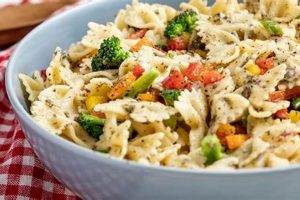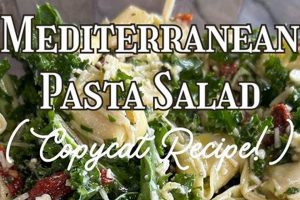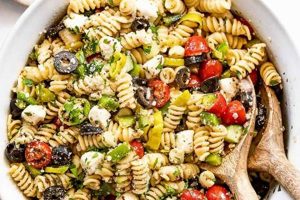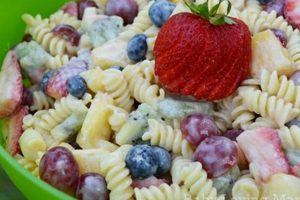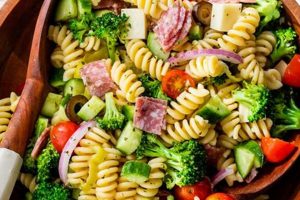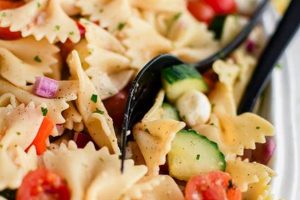This dish typically combines cooked pasta, corn kernels (often grilled or roasted for enhanced flavor), a variety of vegetables like bell peppers, onions, and cilantro, and a vibrant dressing often featuring lime juice, chili powder, and cumin. Variations may include black beans, avocado, cotija cheese, or other ingredients inspired by Mexican cuisine. A well-executed version offers a refreshing and flavorful experience, showcasing the bright, zesty flavors characteristic of the region.
The popularity stems from its versatility. It can be served as a light main course, a satisfying side dish for grilled meats or fish, or a refreshing contribution to potlucks and picnics. Its adaptability to seasonal ingredients allows for year-round enjoyment, while its customizable nature makes it easy to cater to individual preferences. Furthermore, it often features fresh produce, making it a relatively healthy and nutritious meal option.
The following sections will delve deeper into specific ingredient selections, offer variations on the classic preparation, and provide step-by-step instructions to guide the creation of this flavorful and versatile dish. Techniques for grilling corn, creating the perfect dressing, and achieving optimal pasta texture will also be explored.
Tips for an Exceptional Corn and Pasta Salad
Elevating a simple corn and pasta salad to an extraordinary culinary experience involves attention to detail and an understanding of flavor combinations. The following tips provide guidance for achieving optimal results.
Tip 1: Corn Selection and Preparation: Freshly grilled or roasted corn significantly enhances the overall flavor profile. If using canned or frozen corn, ensure it is thoroughly drained and patted dry to prevent excess moisture from diluting the dressing.
Tip 2: Pasta Choices: Short, sturdy pasta shapes like rotini, fusilli, or penne hold the dressing well and provide textural contrast. Cook pasta al dente to maintain a firm bite.
Tip 3: Balancing Flavors: The dressing should achieve a balance of acidity, sweetness, and spice. Adjust lime juice, sugar or honey, and chili powder levels to achieve desired flavor intensity.
Tip 4: Fresh Herbs: Generous use of fresh cilantro, parsley, or other herbs elevates the freshness and complexity of the salad. Add herbs just before serving to preserve their vibrancy.
Tip 5: Ingredient Incorporation: Combine ingredients while the pasta is still slightly warm to facilitate absorption of the dressing and enhance flavor distribution.
Tip 6: Chill Time: Allowing the salad to chill for at least 30 minutes before serving allows the flavors to meld and deepen. This enhances the overall dining experience.
Tip 7: Textural Variety: Consider incorporating elements like chopped bell peppers, red onion, or black beans for added texture and nutritional value.
Tip 8: Optional Enhancements: Crumbled cotija cheese or a dollop of sour cream or Greek yogurt can add a creamy counterpoint to the other flavors. Avocado provides a rich, buttery element.
By following these guidelines, one can create a corn and pasta salad that is both flavorful and visually appealing. Attention to these details ensures a delightful culinary experience.
The subsequent section provides a complete recipe incorporating these tips, enabling readers to confidently create their own exceptional dish.
1. Fresh Corn
Fresh corn plays a pivotal role in a Mexican corn pasta salad, contributing significantly to its characteristic sweetness and overall flavor profile. Utilizing fresh corn, particularly during its peak season, offers a noticeable difference in taste compared to canned or frozen alternatives. The natural sugars present in freshly harvested kernels impart a vibrant sweetness that complements the other ingredients, balancing the acidity of the lime juice and the heat of the chili spices. For example, grilling fresh corn kernels intensifies their sweetness and adds a subtle smoky char, further enhancing the complexity of the salad. This nuanced flavor is difficult to replicate with processed corn, often resulting in a less dynamic dish.
The textural element of fresh corn also contributes to the salad’s appeal. Plump, juicy kernels provide a pleasant burst of texture that contrasts with the firmness of the pasta and other vegetables. This textural interplay adds another layer of enjoyment to the dining experience. Conversely, canned corn can sometimes exhibit a softer, less desirable texture. Practically, sourcing fresh corn during its season ensures optimal sweetness and texture, elevating the final product. Even outside of peak season, seeking out high-quality fresh corn from local markets can still offer a superior flavor compared to processed options.
In summary, the preference for fresh corn in this dish stems from its distinct contribution to both flavor and texture. While substitutes may offer convenience, the superior taste and textural nuance of fresh corn significantly elevate the quality and authenticity of a Mexican corn pasta salad. Understanding this connection allows for informed ingredient selection, optimizing the overall sensory experience.
2. Pasta Choice
Pasta selection significantly influences the overall success of a Mexican corn pasta salad. The chosen shape affects both the aesthetic presentation and the practical enjoyment of the dish. Short, sturdy pasta varieties such as rotini, fusilli, or penne are generally preferred. Their compact structure holds the dressing effectively, ensuring each bite delivers a balanced flavor profile. Furthermore, these shapes offer textural interplay with the other ingredients, creating a more dynamic sensory experience. Conversely, long, thin pasta like spaghetti or linguine tends to become tangled and difficult to manage in a salad setting, diminishing its appeal and practicality. Choosing an unsuitable pasta shape can lead to a less satisfying experience, as the dressing may not distribute evenly, and the overall texture may lack harmony. For example, a robust farfalle pasta can visually anchor the salad and provide ample surface area for the dressing to cling to, while delicate angel hair pasta would likely clump together and become overwhelmed by the other components.
Beyond shape, the pasta’s cooking method also merits consideration. Overcooked pasta becomes mushy and lacks the structural integrity needed to hold its own within the salad. Conversely, undercooked pasta presents an unpleasant, firm texture. The ideal consistency is al dentefirm to the bite yet fully cooked. This ensures the pasta contributes a pleasant chewiness without detracting from the other elements. Achieving the correct texture requires precise timing and attention during the cooking process, as well as prompt draining and rinsing to halt further cooking. For instance, perfectly cooked rotini will maintain its spiral shape and offer a slight resistance when bitten, enhancing the overall textural experience of the salad. Overcooked rotini, however, will lose its definition and become gummy, negatively impacting the salad’s appeal.
In summary, thoughtful pasta selection is crucial for optimizing both the visual appeal and the palatable experience of a Mexican corn pasta salad. Selecting appropriately shaped and properly cooked pasta ensures the dish achieves its full potential. Neglecting this aspect can result in a less satisfying, and potentially unappetizing, outcome. Understanding the impact of pasta choice empowers informed decision-making, leading to a more successful and enjoyable culinary creation.
3. Vibrant Dressing
The dressing serves as the unifying element in a Mexican corn pasta salad, binding the diverse ingredients and imparting a cohesive flavor profile. A vibrant, well-balanced dressing elevates the dish beyond a simple assembly of components, transforming it into a harmonious and flavorful experience. The dressing’s characteristics significantly influence the overall perception of the salad, impacting its palatability and appeal.
- Acidity:
The acidic component, typically lime juice, provides brightness and cuts through the richness of the other ingredients. This tartness balances the sweetness of the corn and the savory notes of the spices. For example, fresh lime juice offers a cleaner, more vibrant acidity compared to bottled lime juice, which can sometimes taste artificial. The correct level of acidity is crucial; too much can make the salad overly tart, while too little can result in a bland, uninspired dish. The acidity also acts as a preservative, helping to maintain the freshness of the salad.
- Spice Level:
Chili powder, often combined with other spices like cumin and oregano, introduces warmth and complexity. The level of spice should complement the other flavors without overpowering them. Using a blend of chili powders, such as ancho and chipotle, can add depth and nuance to the heat. The balance of spice is subjective and can be adjusted to individual preferences. For instance, a mild chili powder might be preferred for a family gathering, while a more robust blend could cater to those who enjoy a spicier palate.
- Sweetness:
A touch of sweetness, often derived from a small amount of sugar or honey, balances the acidity and spice, creating a more rounded flavor profile. This subtle sweetness enhances the overall palatability of the salad, making it more appealing to a wider range of tastes. The sweetness should be subtle and not cloying, allowing the other flavors to shine through. For example, a touch of agave nectar can provide a subtle sweetness with a hint of caramel flavor.
- Oil:
A neutral oil, such as canola or vegetable oil, provides a medium for distributing the flavors and contributes to the overall texture of the dressing. The oil also helps to coat the pasta and other ingredients, preventing them from drying out and enhancing their visual appeal. Using a high-quality oil can subtly improve the flavor of the dressing, while a lower-quality oil might introduce undesirable notes. For instance, extra virgin olive oil, while flavorful, might overpower the delicate balance of the other ingredients, whereas a neutral oil allows the other flavors to take center stage.
These elements work synergistically to create a vibrant dressing that enhances the overall enjoyment of the Mexican corn pasta salad. A well-executed dressing transforms individual ingredients into a cohesive and flavorful whole. Each component plays a specific role, contributing to the balance and complexity of the final dish. The interplay of these elements creates a symphony of flavors that defines the character of the salad. For instance, a bright, citrusy dressing with a hint of chili heat complements the sweetness of the corn and the earthiness of the beans, creating a balanced and refreshing culinary experience.
4. Mexican Spices
Mexican spices constitute a defining characteristic of a Mexican corn pasta salad, differentiating it from other pasta salad variations and contributing significantly to its authentic flavor profile. These spices, often encompassing a blend of chili powder, cumin, oregano, and garlic powder, introduce a complex interplay of savory, earthy, and subtly sweet notes. This complexity elevates the dish beyond a simple combination of ingredients, creating a layered and nuanced culinary experience. The specific blend and proportions of these spices can be adjusted to achieve desired levels of heat and depth, catering to individual preferences. For example, a blend emphasizing ancho chili powder imparts a rich, smoky flavor, while a focus on chipotle powder introduces a more pronounced smokiness with a lingering heat. Omitting or substituting these spices with non-Mexican alternatives would fundamentally alter the dish’s character, resulting in a distinctly different flavor profile.
The interaction of these spices with the other ingredients is crucial. The spices complement the sweetness of the corn, providing a savory counterpoint. They also enhance the inherent flavors of the vegetables, such as bell peppers and onions, creating a synergistic blend of tastes. Furthermore, the spices interact with the dressing, contributing to its overall complexity and depth. For instance, the warmth of cumin enhances the brightness of lime juice, while the earthiness of oregano complements the herbaceous notes of cilantro. This interplay of flavors creates a balanced and harmonious taste experience. Understanding these interactions allows for informed adjustments to the recipe, ensuring the spices enhance, rather than overpower, the other components.
In conclusion, Mexican spices are integral to the authenticity and complexity of a Mexican corn pasta salad. Their careful selection and application contribute significantly to the overall flavor profile, differentiating this dish from other pasta salad variations. The interplay of these spices with other ingredients creates a nuanced and balanced culinary experience. Recognizing the importance of these spices and understanding their interactions empowers informed recipe adjustments, optimizing the final dish and ensuring a truly authentic and flavorful outcome.
5. Complementary Vegetables
Complementary vegetables play a crucial role in a Mexican corn pasta salad, contributing not only to its nutritional value but also to its textural and flavor complexity. These vegetables extend beyond mere garnish, functioning as integral components that enhance the overall sensory experience. Their selection and preparation influence the salad’s balance, freshness, and visual appeal. For instance, diced bell peppers introduce a crisp, sweet element, while finely chopped red onion adds a pungent bite. The combination of textures, ranging from the crunch of raw vegetables to the slight chewiness of the pasta and corn, creates a more dynamic and satisfying meal.
The choice of complementary vegetables can also significantly impact the nutritional profile of the salad. Incorporating nutrient-rich options like chopped romaine lettuce, black beans, or shredded carrots increases the fiber, vitamin, and mineral content. This allows for a more balanced and healthful meal option. Furthermore, the variety of colors introduced by these vegetables enhances the visual appeal, making the salad more appetizing. For example, the vibrant green of cilantro, the deep red of bell peppers, and the bright yellow of corn create a visually stimulating dish. This visual appeal contributes to the overall enjoyment of the meal, making it more enticing and satisfying. The careful selection of complementary vegetables can also cater to dietary restrictions or preferences. For individuals seeking a lower-carbohydrate option, focusing on non-starchy vegetables like zucchini or cauliflower can provide a satisfying and healthful alternative.
In summary, the incorporation of complementary vegetables in a Mexican corn pasta salad extends beyond simple aesthetics. These vegetables play a multifaceted role, contributing to the salad’s nutritional value, textural complexity, and overall flavor profile. Understanding their importance allows for informed choices that optimize both the healthfulness and the palatability of the final dish. Thoughtful selection and proper preparation of these vegetables elevate the salad from a basic side dish to a well-rounded and satisfying meal. This attention to detail ultimately distinguishes a truly exceptional Mexican corn pasta salad.
6. Optional additions (cheese, avocado)
Optional additions, such as cheese and avocado, while not essential to the core definition of a Mexican corn pasta salad, offer opportunities to enhance the dish’s flavor profile, textural complexity, and overall richness. These additions contribute nuanced layers that elevate the salad from satisfying to exceptional. The judicious use of these optional components allows for customization based on individual preferences and dietary considerations. For example, incorporating crumbled cotija cheese introduces a salty, tangy element that complements the sweetness of the corn and the spice of the dressing. The crumbly texture of the cheese also provides a pleasant contrast to the other ingredients. Similarly, the addition of diced avocado contributes a creamy richness and a healthy dose of monounsaturated fats. The smooth texture of the avocado contrasts beautifully with the crunch of the vegetables and the chewiness of the pasta. However, the inclusion of these additions should be considered carefully, as they can impact the overall balance of the dish. Overuse of cheese can lead to excessive saltiness, while too much avocado can make the salad overly rich and heavy.
The choice of cheese significantly influences the final flavor profile. Cotija, a firm, salty Mexican cheese, offers a classic pairing, but other options, such as queso fresco or feta, can provide interesting variations. Similarly, the ripeness of the avocado is crucial. A perfectly ripe avocado contributes a creamy texture and a subtle, nutty flavor, while an overripe avocado can introduce an undesirable mushiness and a bitter taste. The preparation method also merits consideration. While diced avocado is a common choice, thinly sliced or mashed avocado can offer alternative textural experiences. Furthermore, the timing of adding these ingredients can impact their effectiveness. Avocado, being susceptible to browning, is best added just before serving. Cheese, on the other hand, can be incorporated earlier, allowing its flavors to meld with the other ingredients. These seemingly minor details can significantly impact the overall enjoyment of the dish.
In conclusion, while cheese and avocado are considered optional additions, their strategic inclusion can elevate a Mexican corn pasta salad from simple to extraordinary. Understanding the impact of these ingredients on flavor, texture, and overall balance allows for informed choices that cater to individual preferences and optimize the final product. Careful consideration of cheese type, avocado ripeness, and incorporation timing ensures these optional additions enhance, rather than detract from, the overall culinary experience.
7. Proper Chilling Time
Proper chilling time is integral to a successful Mexican corn pasta salad recipe, significantly impacting the final dish’s flavor development and overall palatability. Chilling allows the diverse flavors from individual componentsthe sweetness of corn, the acidity of the lime dressing, the savory spices, and the freshness of vegetablesto meld and harmonize. This integration creates a more cohesive and complex flavor profile than a freshly made, unchilled salad. The chilling process also enhances the salad’s refreshing quality, making it particularly appealing in warmer weather. For example, a salad chilled for at least 30 minutes exhibits a more pronounced and balanced flavor compared to one consumed immediately after preparation. The flavors become more integrated, and the overall taste experience is noticeably enhanced.
Beyond flavor development, proper chilling time also affects the salad’s texture. Chilling firms the pasta, preventing it from becoming mushy and ensuring a pleasant bite. It also allows the dressing to further penetrate the pasta and vegetables, enhancing their flavor absorption. For instance, chilled pasta maintains its structural integrity, providing a desirable textural contrast to the other ingredients. Conversely, unchilled pasta may absorb too much dressing, becoming overly soft and losing its distinct texture. This can negatively impact the overall balance and enjoyment of the salad. The temperature of the salad itself also contributes to its appeal. A chilled salad offers a refreshing contrast, especially when served during hot weather, further enhancing its palatability.
In summary, proper chilling time is not merely a suggestion but a critical step that elevates the Mexican corn pasta salad from a collection of ingredients to a cohesive and flavorful dish. The chilling period allows for flavor integration, texture enhancement, and overall improvement in palatability. Understanding the importance of this step and incorporating it into the preparation process ensures a more satisfying and enjoyable culinary experience. Neglecting this seemingly simple step can compromise the final product, hindering the full realization of the salad’s potential. Proper chilling time is thus an essential element for achieving the desired flavor balance and textural complexity that define a truly exceptional Mexican corn pasta salad.
Frequently Asked Questions
This section addresses common inquiries regarding the preparation and enjoyment of Mexican corn pasta salad.
Question 1: Can frozen or canned corn be substituted for fresh corn?
While fresh corn is preferred for optimal flavor and texture, frozen or canned corn can be substituted. If using canned corn, ensure thorough draining to prevent excess moisture from diluting the dressing. Frozen corn should be thawed and patted dry before incorporation.
Question 2: What type of pasta is most suitable for this salad?
Short, sturdy pasta shapes like rotini, fusilli, or penne are recommended. These shapes hold the dressing well and offer textural contrast. Avoid long, thin pasta varieties which tend to tangle and become difficult to manage.
Question 3: Can the spice level be adjusted?
Spice levels are easily adjustable. Reduce or increase the amount of chili powder according to preference. Consider using milder chili powders or incorporating a touch of cayenne pepper for added heat.
Question 4: How long can the salad be stored in the refrigerator?
Properly stored in an airtight container, the salad can be refrigerated for up to three days. The texture of the ingredients may soften slightly over time.
Question 5: What are suitable protein additions to make this a complete meal?
Grilled chicken, shrimp, or black beans are excellent protein additions. Canned tuna or salmon can also be incorporated. Consider vegetarian protein sources like chickpeas or tofu.
Question 6: Can the dressing be made in advance?
The dressing can be prepared a day in advance and stored separately in the refrigerator. This allows the flavors to meld and intensify. Whisk thoroughly before combining with the salad ingredients.
Careful consideration of these frequently asked questions ensures optimal preparation and a more enjoyable culinary outcome. Understanding these common points of inquiry facilitates successful creation of a flavorful and satisfying Mexican corn pasta salad.
The following section offers a complete, step-by-step recipe guide, incorporating the insights provided throughout this article.
Mexican Corn Pasta Salad Recipe
Exploration of the Mexican corn pasta salad recipe reveals a dish characterized by a vibrant interplay of flavors and textures. Fresh corn, ideally grilled or roasted, provides a foundational sweetness, complemented by the robust spices characteristic of Mexican cuisine. Careful pasta selection ensures structural integrity and optimal dressing adherence. A balanced dressing, featuring lime juice, chili powder, and subtle sweetness, unifies the diverse ingredients. Complementary vegetables contribute textural nuance and nutritional value, while optional additions like cotija cheese and avocado offer further complexity. Proper chilling allows flavors to meld, enhancing the overall dining experience.
Mastery of this recipe offers not merely a palatable dish but an opportunity to explore the rich tapestry of Mexican culinary traditions. Adaptability to seasonal ingredients and individual preferences ensures enduring appeal. This dish represents more than a simple salad; it embodies a culinary synthesis, transforming individual components into a harmonious and satisfying whole. Further exploration and experimentation with variations promise continued culinary discovery and enjoyment.

